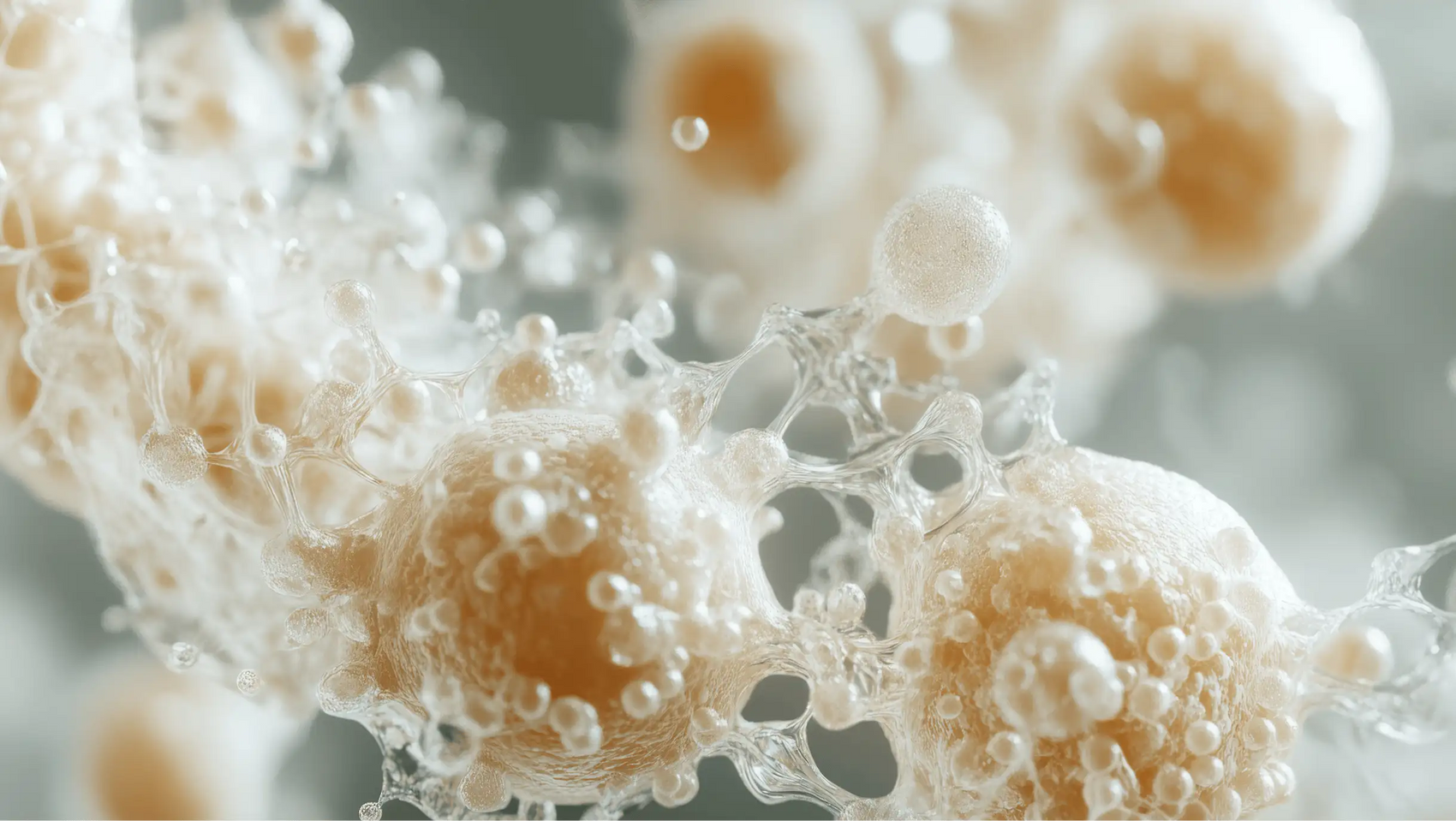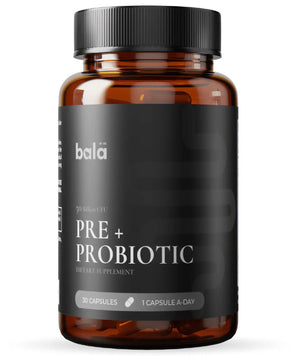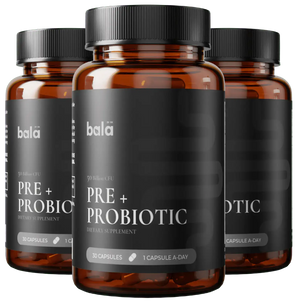Table of Contents
- Introduction
- Understanding Prebiotics and Probiotics
- The Benefits of Prebiotics and Probiotics
- Foods That Contain Prebiotics
- Foods That Contain Probiotics
- Combining Prebiotics and Probiotics: Synbiotics
- How to Incorporate Prebiotics and Probiotics into Your Diet
- The Role of Bala Health Probiotic
- Conclusion
- FAQ
Introduction
Did you know that your gut is home to trillions of microorganisms that play a crucial role in your overall health? It’s true! This complex ecosystem, known as the gut microbiome, affects everything from digestion to mood and immune function. However, maintaining a healthy gut can be challenging, especially with the modern diet often lacking in essential nutrients. Are you tired of the confusion and skepticism in the probiotic aisle? Struggling to find a solution for bloating that you can trust?
In this blog post, we will explore the fascinating world of prebiotics and probiotics—two key components that can help support your gut health. We’ll delve into what foods contain these beneficial compounds, how they work, and why they are essential for our well-being. By the end of this article, you’ll have a clearer understanding of how to incorporate prebiotic and probiotic foods into your diet, and how our clean, science-backed probiotics at Bala Health can support your gut journey.
Our mission at Bala Health is to help you feel better from the inside out by providing clean, functional, and trustworthy probiotics that deliver real results. We stand by our values of science-first, transparency, simplicity, empowerment, and integrity—ensuring that you can make informed decisions about your gut health.
Let’s kick-start our journey into the world of gut health!
Understanding Prebiotics and Probiotics
Before we dive into specific foods, it’s essential to understand what prebiotics and probiotics are and how they differ.
What Are Prebiotics?
Prebiotics are non-digestible food components, primarily fibers, that serve as food for beneficial gut bacteria. They help to stimulate the growth and activity of these good bacteria, promoting a healthier gut environment. Think of prebiotics as the fertilizer for the garden of your gut—encouraging the growth of healthy flora.
Common types of prebiotics include:
- Inulin
- Fructo-oligosaccharides (FOS)
- Galacto-oligosaccharides (GOS)
What Are Probiotics?
Probiotics, on the other hand, are live microorganisms, often referred to as “good” bacteria. They can be found in fermented foods and supplements. When consumed in adequate amounts, probiotics can confer health benefits to the host, such as improved digestion and enhanced immune function.
Common probiotic strains include:
- Lactobacillus
- Bifidobacterium
- Saccharomyces boulardii (a yeast)
Together, prebiotics and probiotics work synergistically to maintain gut health. While prebiotics feed the good bacteria, probiotics introduce live strains to the gut, creating a balanced microbiome.
The Benefits of Prebiotics and Probiotics
Understanding the benefits of these components can help motivate us to incorporate them into our diets. Here’s how both prebiotics and probiotics contribute to our overall health:
Benefits of Prebiotics
- Gut Health: Prebiotics enhance the growth of beneficial bacteria, improving digestion and reducing the risk of gastrointestinal disorders.
- Immune Function: A balanced microbiome can help modulate the immune system, potentially reducing inflammation and the risk of infections.
- Nutrient Absorption: By promoting a healthy gut environment, prebiotics can improve the absorption of essential nutrients, including calcium and magnesium.
- Weight Management: Some studies suggest that prebiotics may play a role in appetite regulation and weight control by influencing gut hormones.
Benefits of Probiotics
- Digestive Health: Probiotics can aid in alleviating digestive issues, such as bloating and irregular bowel movements.
- Immune Support: Probiotics can enhance immune response and help fend off harmful pathogens.
- Mental Health: Emerging research suggests a link between gut health and mental well-being, with probiotics potentially affecting mood and anxiety levels.
- Skin Health: Some probiotic strains may benefit skin conditions like eczema and acne by improving gut health.
Foods That Contain Prebiotics
Incorporating prebiotic-rich foods into our diets can help foster a healthy gut microbiome. Here’s a list of some of the best foods to include:
1. Garlic
Garlic is not only a flavorful addition to many dishes but also a powerhouse of prebiotics. It contains inulin and FOS, which can stimulate the growth of beneficial gut bacteria.
2. Onions
Onions are another excellent source of prebiotics, particularly inulin. They can be used in a variety of dishes, from salads to soups.
3. Asparagus
Asparagus is rich in inulin and is particularly beneficial when consumed raw or lightly cooked. Add it to salads or stir-fries for a crunchy texture.
4. Bananas
Bananas are not only a convenient snack but also contain small amounts of prebiotics, including inulin. They can help promote gut health while providing essential vitamins and minerals.
5. Oats
Whole oats are high in beta-glucans, which act as prebiotics. They can be enjoyed as oatmeal, in smoothies, or baked into treats.
6. Chicory Root
Chicory root is often used as a coffee substitute and is an excellent source of inulin. It can be added to smoothies or consumed in tea form.
7. Jerusalem Artichokes
This tuber is rich in inulin and can be eaten raw in salads or cooked in various dishes. It has a nutty flavor that adds depth to meals.
8. Dandelion Greens
These leafy greens are packed with fiber and antioxidants. They can be used in salads or smoothies to boost your prebiotic intake.
9. Apples
Apples are not only delicious but also contain pectin, a type of soluble fiber that acts as a prebiotic. Enjoy them raw, in salads, or baked.
10. Barley
Barley is a whole grain high in fiber and prebiotics. It can be added to soups, stews, or salads for a hearty meal.
Foods That Contain Probiotics
In addition to prebiotic-rich foods, it’s essential to consume foods that provide probiotics. Here are some of the best sources:
1. Yogurt
Yogurt is perhaps the most well-known source of probiotics. Opt for plain, unsweetened varieties to avoid added sugars.
2. Kefir
Kefir is a fermented dairy product similar to yogurt but with a thinner consistency. It contains a wider variety of probiotic strains.
3. Sauerkraut
Fermented cabbage, or sauerkraut, is rich in probiotics and can be added to salads, sandwiches, or enjoyed as a side dish.
4. Kimchi
This traditional Korean dish made from fermented vegetables, typically cabbage and radishes, is not only spicy but also packed with probiotics.
5. Miso
Miso is a fermented soybean paste used in Japanese cuisine. It can be added to soups, dressings, or marinades for a flavorful boost.
6. Tempeh
Tempeh is a fermented soybean product that is a great source of protein and probiotics. It can be used in stir-fries, salads, or sandwiches.
7. Kombucha
This fermented tea beverage is rich in probiotics and can be enjoyed as a refreshing drink. Just be mindful of added sugars!
8. Pickles
Fermented pickles (not those made with vinegar) can be a tasty source of probiotics. Be sure to check the label for live cultures.
Combining Prebiotics and Probiotics: Synbiotics
Some foods combine both prebiotics and probiotics, often referred to as synbiotics. These foods can be particularly beneficial for gut health as they provide both the nourishment and the live microorganisms necessary for a balanced microbiome. Some examples of synbiotic foods include:
- Yogurt with added fiber (e.g., inulin)
- Fermented foods containing prebiotic ingredients (e.g., kimchi with garlic or onions)
- Probiotic supplements that include prebiotic fibers
How to Incorporate Prebiotics and Probiotics into Your Diet
- Start Small: If you’re new to prebiotics and probiotics, start by incorporating one or two items from each category into your diet.
- Mix and Match: Combine different prebiotic and probiotic foods to create balanced meals. For example, add yogurt to a smoothie with bananas and oats.
- Experiment with Recipes: Try new recipes that include prebiotic and probiotic ingredients. For instance, make a hearty soup with onions, garlic, and miso.
- Stay Consistent: Make prebiotic and probiotic foods a regular part of your diet, aiming for a variety of sources to promote gut diversity.
The Role of Bala Health Probiotic
At Bala Health, we understand that while food is a vital source of prebiotics and probiotics, sometimes our busy lives make it difficult to get enough of these essentials through diet alone. That’s where our clean, science-backed probiotics come in. Our formulations are designed to support your gut health effectively, using clinically validated strains and doses backed by real research.
By incorporating our probiotic into your daily routine, you can enhance the benefits of the prebiotic-rich foods you're consuming. Start your journey to better gut health – Shop our clinically-backed probiotic now and feel better from the inside out!
Conclusion
Maintaining a healthy gut is essential for overall wellness, and incorporating prebiotic and probiotic foods into your diet can make a significant difference. By understanding which foods provide these vital components and how they work together, you can take proactive steps towards better digestive health.
We encourage you to explore the world of prebiotics and probiotics, experiment with various foods, and consider adding our trusted Bala Health probiotic to your daily routine.
Ready to take control of your gut health? Kick-start your transformation—take our 3-minute Weight-Loss Quiz and discover your personalized gut-health roadmap!
FAQ
What are some easy ways to include more prebiotic foods in my diet?
Start by adding garlic and onions to your meals, snacking on bananas, and incorporating oats into your breakfast routine.
Can I take prebiotics and probiotics together?
Yes, taking them together can be beneficial. Prebiotics serve as food for probiotics, helping them thrive in the gut.
How long does it take to see the benefits of prebiotics and probiotics?
The time frame can vary, but many people notice improvements in digestion and overall well-being within a few weeks of consistent consumption.
Are there any side effects to taking prebiotics or probiotics?
While generally considered safe, some individuals may experience mild digestive discomfort when first introducing high amounts of prebiotics. It’s best to increase intake gradually.
How do I choose a quality probiotic supplement?
Look for products that contain clinically studied strains and are transparent about their ingredients and manufacturing processes, like our Bala Health probiotic.







